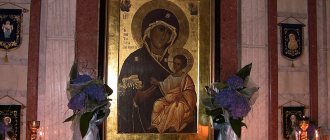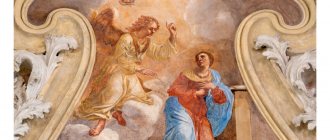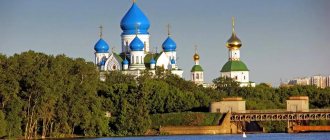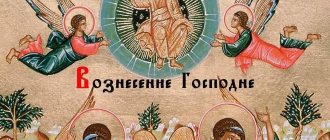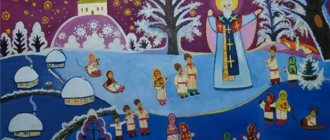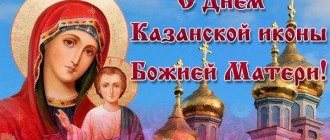What date is the day of the Iveron Icon of the Mother of God celebrated?
The following dates are associated with this image:
- February 25 - according to the Gregorian calendar (or February 2 according to the Julian style). Then the copy of the Iveron Icon was transferred to the monastery located in the city of Valdai. This event took place in 1656.
- October 26 – according to the Gregorian calendar (or October 13 according to the Julian calendar). In Moscow, the copy of the Iveron Icon, which ruler Alexei Mikhailovich sent from the Holy Mount Athos, is solemnly greeted and transferred.
Therefore, believers celebrate the feast of the miraculous shrine several times a year, but the second date ( October 26 ) is considered more common.
Historical information about the discovery of the miraculous image
Find out what awaits you today - Horoscope for today for all zodiac signs
Due to numerous requests from subscribers, we have prepared an accurate horoscope application for mobile phones. Forecasts will arrive for your zodiac sign every morning - it's impossible to miss! Download for free: Daily Horoscope 2020 (available on Android)
The first written evidence about the icon that has survived to this day is Greek - dates back to the 16th century, and Slavic - to the 15th century AD. There is no single version about how the Iveron Icon of the Mother of God appeared - there are several assumptions on this matter, but they all contradict each other. Let's look further at the most popular version.
According to it, in the 9th century, the miraculous image, now known as the Iveron image, was carefully kept by one believing widow. The woman lived near the city of Nicaea. During the reign of Emperor Theophilus (from 829 to 842), mass destruction of Christian shrines was carried out. The iconoclasts also reached the home of the righteous widow. The soldiers discovered the icon, and one of them hit it with a spear, after which real blood began to ooze from the face of the Virgin Mary.
The widow was very afraid that the shrine would be destroyed, so she invited the emperor’s soldiers to take the money and allow them to keep the image until the next morning. They left, and the woman, together with her son (who would later become an Athonite monk), trying to save the image, betrayed it to the waves of the sea.
It is believed that two centuries later the icon miraculously floats to Mount Athos. Servants at the Georgian Iveron Monastery, which stands on the Holy Mountain, for several days could observe how a pillar of fire emerged from the water and stretched to the very sky. The monks decided to check what was there and went ashore. There they discovered the holy icon, which stood on the waves of the sea.
The monks performed a prayer service of thanks to the Lord for giving the monastery a shrine. After which, during a night's rest, the pious servant of the monastery, Gabriel the Svyatogorets, has a vision of the Mother of God. In it, Saint Mary commands to walk on the water, take the holy image and leave it in the monastery. The monk did what he was told. But then events began to unfold in an amazing way: the next day the monks discover the icon not in the temple, but above its gates.
This is repeated more than once and lasts until the Mother of God again reveals her desire to Gabriel in a dream. It consisted in the fact that the Virgin Mary did not want to be protected by the members of the monastery, but to protect them herself. Then the icon was placed above the monastery gates. This is where its other names came from - Portaitissa or Goalkeeper. The image was named Iversky from the name of its location - that is, the Iversky Monastery.
At first, the Goalkeeper was located outside, in a shrine not far from the entrance. Then a small temple was built for her inside the monastery, on the left side of the gate, where she remains until today. Versions about the date when the appearance of the holy icon occurred also differ - some call March 31, others April 27.
As for the Iversky Monastery itself, here the feast of the shrine of the same name is celebrated on Tuesday during Bright Week (that is, the week starting with Easter and lasting until the next Sunday). On the solemn day, the monks make a religious procession to the sea coast, where, according to legend, the icon was found by the monk Gabriel in time immemorial.
History of writing the icon
The miraculous image was painted by the Evangelist Luke during the life of the Mother of God, with her permission. The image was imprinted on a board from the dining table where the holy family ate. Church tradition says that the icon belongs to the brush of Evangelist Luke, one of the seventy apostles.
Once Saint Luke traveled to Greece, where after his fervent sermons hundreds of people were baptized. Among those who applied was a certain rich ruler who wanted to donate a significant sum of money for the construction of a temple on Mount Athos. Delighted by such a donation, Saint Luke presented the ruler with an icon he had drawn, which became a family heirloom. Since the temple was called Iveron, the icon was given a name in honor of this temple - the Iveron Mother of God.
The icon remained in the Byzantine family until the 9th century, when persecution of icon painters and icons began. To save it, the holy relic was placed in a barrel, filled with resin and thrown into the sea. Further, the legend says that this barrel was washed up by a wave directly against the walls of the Iveron Monastery on Mount Athos: it returned to its native shores. The barrel was found by a monk named Gabriel. He was just walking along the seashore when he saw a pillar of light. Approaching closer, the monk saw an icon of the Mother of God in a column of light, and next to it the fragments of a barrel.
Another name for the Iveron Icon of the Mother of God is the Goalkeeper or Gatekeeper.
The monk took the wonderful icon to the abbot of the monastery, where a solemn liturgy was held. The image was placed on the altar with honor, however, in the morning the monks found it on the canopy of the monastery gate. The icon miraculously moved itself from the temple to the gate. They tried to place it in other places of the temple, but there was always one result: it again ended up at the gate. And then people began to notice that after passing through the monastery gates they received healing.
The fame of the miraculous icon quickly spread throughout the Orthodox world, and pilgrims began to flock to Athos to venerate the miraculous Face. The monks scrupulously kept records of healings and other miracles that happened to this icon.
To protect the icon from bad weather and bright sun rays, a glass box decorated with gold embossing was made for it. The icon along with this box was stolen more than once, but each time it returned to its place in the most incredible way. Since the location of the image was on the gate, it received the name - Vratarnitsa (Gatekeeper). The fame of the icon thundered throughout the Orthodox world; many copies were made of it. The lists were also distinguished by their healing power; miracles happened to them.
Miracles icons
The image of the Mother of God became a reliable protection of the Iveron Monastery from various adversities. One day, a Persian fleet sailed to the island with the intention of plundering the monasteries. The monks began diligently offering prayers to their protector and savior - the Iveron Icon. At this time, a terrible storm arose at sea, which sank the Persian ships. The surviving Persians were greatly frightened; their leaders left generous donations to the monastery and never again tried to attack the monks.
One day there was a famine, and the monastery's food supplies were rapidly disappearing. The monks were in despair and did not know what to do. The clergy prayed to the icon day and night and asked for intercession. One night, the abbot of the monastery had a strange dream: the Ever-Virgin ordered him to go down and check the monastery barns. Imagine the abbot’s surprise when he saw the reserves of olive oil, wine and grain filled to the ceiling.
The monastery books also contain testimonies of ordinary parishioners, which indicated all the miracles that occurred through prayer to the miraculous image. Basically, these were thanks for healing from serious and, at times, deadly illnesses.
The Bright Image always warned the monks about future troubles and misfortunes. So, before the start of World War II, the monks noticed that the Face was looking menacingly from the icon, and the lamp oil was swaying. The Most Pure Virgin also warned about the Hagaran invasion of the island of Cyprus, military expansion into Iraq, and an earthquake in Spitak (Armenia). The monks testify that on the eve of sad or alarming events, the icon begins to sway, as it were.
Holiday traditions
Now let's talk in more detail about the traditions of this day. According to the popular calendar, October 26 is called Bannik or Bath Day. It has come down to us from the times when paganism was the main religion on Russian lands. Then, on the specified date, a traditional bath in the bathhouse should have been organized.
When going to take a steam bath, they were sure to stock up on infusions made from various herbs, which were believed to have healing powers and could even cure epilepsy. People believed that the bannik (that is, the spirit living in the bathhouse) expels their ailments from the sick. But to do this, you need to show respect to him - first of all, when entering the bathhouse, get rid of the cross on your body. And they didn’t forget to ask the bath attendant for permission to go take a steam bath and swim.
People tried to adhere to specific, strict rules, because they believed that if they broke them, they would bring upon themselves many troubles and misfortunes. For example, they didn’t go to the bathhouse at night, believing that then the bathhouse owner himself wanted to swim and they could stop him. The spirit was represented as an incorporeal creature, sometimes turning into a dog, cat, hare or frog. When leaving the bathhouse on October 26, he was left with water and a broom with soap overnight.
Under no circumstances were icons or other Christian attributes brought into the bathhouse. Otherwise, it was possible to anger the bannik, but he would already find a way to take revenge - for example, throw a stone at the offender. And the most useful time spent in the steam room was considered to be when it was the third, fourth or seventh steam.
Since pagan times, the custom of not being alone and in the dark on October 26 has been preserved: since ancient times, people tried to go for a walk on this day, lit fires, and lit candles in their houses - in order to prevent evil spirits (bad spirits) from getting into the home and causing harm.
Interesting! On a holiday, it is not recommended to refuse invitations to visit; be sure to make a guest visit if you are invited.
These were traditions more related to pagans. Let's now talk about Orthodox people. On October 26, they should visit the temple, where the clergy conduct a festive service and read special prayers dedicated to the icon of the Virgin Mary. Believers turn to the Mother of God with requests to protect them from all evil, improve their health, and forgive any sins.
What is unacceptable to do on the day of the celebration of the Iveron Icon of the Mother of God?
- Conflict, argue, use obscene words in speech.
- Refuse to help if you are asked for something.
- Overeat or, even more so, drink a lot of alcoholic beverages.
- Carry out your duties irresponsibly.
- Lies, slander, condemnation or concealment of information are strictly prohibited.
- Envy is another extremely negative feeling in human nature that needs to be gotten rid of. When you see someone else's success, rejoice from the bottom of your heart. And if someone seems to be deliberately provoking you to envy with their boasting, then it is better to minimize contacts with such a person.
- You should not use sharp objects, as there is a high risk of causing injury to yourself. Be very careful with knives, other potentially dangerous tools and fire.
What does it help with?
People turn to the Holy Face for help in worldly needs, to find healing, to receive guidance and advice. The Mother of God will always console you in troubles, support you in difficult times, and strengthen your faith.
The icon is addressed:
- for healing;
- to strengthen faith;
- for a good harvest;
- in moments of danger.
Finding inner purity and holiness is what this holy image bestows on everyone who converts with faith in their hearts. If you are overcome by sinful thoughts and passions, the Mother of God will calm your restless heart and cool your hot head. People turn to the Mother of God not only to resolve their own issues, but also in prayers for their loved ones and relatives. They also pray for their enemies, so that the Lord will enlighten the unfortunate and direct them to the true path.
Where is the best place to place the miraculous image? Traditionally it is placed above the front door, but it can also be placed on the iconostasis. Orthodox Christians are confident that the Mother of God the Goalkeeper saves their home from enemies, robbery, flooding and fire. It will also prevent unnecessary visits and discourage dishonest guests.
We should not forget that the miraculous image saved the monks of the Iveron Monastery from imminent hunger, replenishing their food supplies. Therefore, they pray to the icon for the family budget, so that there is enough money for everything. Of course, you should not squander money: the Mother of God does not help spendthrifts and gluttons.
Signs October 26
The people came up with their own signs for each specific day, according to which they made unique “predictions” of what awaited them in the near future.
- On the feast of the Iveron Icon of the Mother of God, clouds appear from the south - soon the weather conditions will change for the worse.
- Whoever did not bathe on this day and did not change dirty clothes to clean ones will have worse health and will get sick a lot in winter.
- Suddenly, on the evening of October 26, a rooster crowed - a sign of weather changes.
- If the rooster crows early in the morning, it will soon become warmer.
- Red clouds appear in the sky - it will rain.
- The sun peeks out from behind the clouds - the weather will change.
Finally, watch the video on the topic:
Magic rituals
Find out the future
Since ancient times, the Iveron Icon of the Mother of God has helped people learn the secrets of the future. Healers performed a special ritual to obtain information about upcoming events. To do this, you had to read special spell words three times:
Then you had to go to the temple to the image, light a candle and carefully peer at the miraculous image. The answer to the question you need will appear within yourself. Some masters even experience shock from the signs that come from this icon. Lik can:
- shine like the sun;
- to frown;
- cry, sob;
- take on a threatening appearance;
- radiate rays of joy and happiness;
- etc.
If a warning is received about imminent trouble, then the masters reprimand. The rite of reprimand is carried out with the same image of the Goalkeeper.
Is it possible to perform this ritual at home? Yes, you can, but the icon must be of impressive size. If there is a small list in the house, the ritual will not work. It's better to go to the temple.
Love spell
With the help of the Iverskaya icon you can unite the destinies of two people. To do this, you need a photo of the person being bewitched, an icon, candles, a small padlock with a key.
At midnight, cover the table with a clean tablecloth, place an icon in the center, place a photograph on the icon, and place a lock with an open shackle on the photograph. Place 2 church candles on the sides and light them.
Read the Mother of God prayers to the Iveron Icon and say the following spell 33 times in a row:
After reading, immediately close the lock with the key and drop a little wax from a candle into the key hole. You need to keep the key, but the lock should be placed on the church gate in an inconspicuous place. Candle stubs are buried near the house of the person being bewitched.
